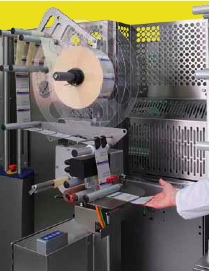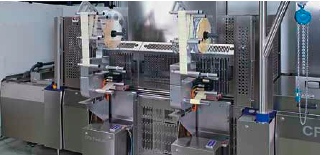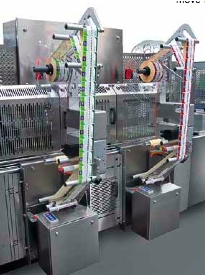
Auto label-reel changes with servo motors, control and visualization tech
November 12, 2009
By Manufacturing AUTOMATION
 For foodstuffs processing lines, downtime for changing label reels or due to torn backing material is not just inconvenient, it costs money. CFS has therefore developed a concept that enables label reels to be changed without stopping the machine. With a thoroughly modular structure, the new labeling machine can be perfectly adapted to the requirements of any application. Up to 16 ACOPOS servo motors, as well as control and visualization technology from B&R provide the necessary dynamics, precision and ease of operation.
For foodstuffs processing lines, downtime for changing label reels or due to torn backing material is not just inconvenient, it costs money. CFS has therefore developed a concept that enables label reels to be changed without stopping the machine. With a thoroughly modular structure, the new labeling machine can be perfectly adapted to the requirements of any application. Up to 16 ACOPOS servo motors, as well as control and visualization technology from B&R provide the necessary dynamics, precision and ease of operation.
“In a typical processing line for lunchmeat or cheese, between 7.5 and 12 percent of all downtime is caused by the labeling equipment,” explains Michael Brandt, product manager for labelling and printing at CFS Germany gmbH in Wallau. The bulk of this downtime is spent exchanging the label reels. Not surprisingly, considering that at typical speeds of high performance packaging machines (eight cycles per minute, 16 products per cycle), an average reel of 5,000 labels is used up after only 40 minutes. If a thermal transfer printer is used, there may be additional downtime required to exchange the carbon tape it requires. If the backing material for the labels is especially thin, flexible or perforated, conventional machines experience additional problems and unexpected downtime due to torn backing material.
Going their separate ways: Label dispenser and applicator unit
 The experts at the CFS competence centre for packaging machines and labelers in Wallau have addressed this problem by developing a new concept, and used this concept to implement a new labeler, the tiroLabelNt. This labeling system is the first cross web labeler on the market that allows label reels to be exchanged during machine operation. This innovation was made possible by creating two separate units for dispensing and applying the labels, functions that were previously grouped in a single construction. The movable applicator unit takes the labels from the stationary dispenser and places them over the products to be labeled. Spring-loaded “fingers” then press the labels onto the products.
The experts at the CFS competence centre for packaging machines and labelers in Wallau have addressed this problem by developing a new concept, and used this concept to implement a new labeler, the tiroLabelNt. This labeling system is the first cross web labeler on the market that allows label reels to be exchanged during machine operation. This innovation was made possible by creating two separate units for dispensing and applying the labels, functions that were previously grouped in a single construction. The movable applicator unit takes the labels from the stationary dispenser and places them over the products to be labeled. Spring-loaded “fingers” then press the labels onto the products.
Equipping the machine with two dispenser units allows the label reels to be exchanged without stopping the machine: to make this possible, the machine must be constructed and programmed so that the applicator unit automatically goes to the second dispenser as soon as the first dispenser is empty or the carbon tape is used up. Since the empty dispenser can be refilled while the second dispenser is working, the machine is now ready for continuous operation. Brandt and his team of experts at CFS have been able to accomplish this thanks to a sophisticated modular system and revolutionary drive and control technology from B&R.
Flexible configuration
 Since the downtimes caused by changing label reels do not present the same problems in every processing line, CFS offers the tiroLabelNt in various models the entry level tiroLabelNt 201 with one dispenser and one applicator unit, tiroLabelNt 202 with two dispensers and one applicator unit for systems with a throughput of 120 to 170 packages per minute, and the high-end model TiroLabelNT 203 with two dispensers and two applicator units for the most demanding applications.
Since the downtimes caused by changing label reels do not present the same problems in every processing line, CFS offers the tiroLabelNt in various models the entry level tiroLabelNt 201 with one dispenser and one applicator unit, tiroLabelNt 202 with two dispensers and one applicator unit for systems with a throughput of 120 to 170 packages per minute, and the high-end model TiroLabelNT 203 with two dispensers and two applicator units for the most demanding applications.
“A labeler with two dispensers has more uses than simply reducing downtime,” Brandt emphasizes. “The user could also apply a second promotional label, such as ‘Two for the price of one’ or ‘Now with 20-percent more,’ without the added time and effort this usually requires.” And if two dispensers and one applicator unit are not enough, there’s always the labeler with two applicator units.
High-tech from B&R makes it possible
The new tiroLabelNt machine concept was only possible using newly developed technology: Since the dispenser and applicator are no longer one unit, and the dispenser is placed in an optimum position for the selected packaging format and remains there during operation, the applicator unit must return to the dispenser after each cycle.
 “Just to achieve the same productivity as conventional systems, the applicator unit must move more quickly than with previous approaches,” Brandt explains. “That’s why our labeler uses a linear motor that can accelerate at 2 Gs to provide the necessary dynamic drive for the applicator unit. In addition to the increased throughput, this technology is also absolutely maintenance-free because it doesn’t require parts such as toothed belts that are subject to wear and tear.” The motor is controlled by an intelligent servo drive from B&R’s ACOpOS line. “B&R agreed right away to handle integration of the linear motor and create all of the drive-related software. This was a great experience for us that confirmed our decision to trust B&R with not only the control and visualization — like with all of our machines — but also with the drive technology.” For the tiroLabelNt the latter was quite extensive: The labeling system utilizes a total of 16 servo drives.
“Just to achieve the same productivity as conventional systems, the applicator unit must move more quickly than with previous approaches,” Brandt explains. “That’s why our labeler uses a linear motor that can accelerate at 2 Gs to provide the necessary dynamic drive for the applicator unit. In addition to the increased throughput, this technology is also absolutely maintenance-free because it doesn’t require parts such as toothed belts that are subject to wear and tear.” The motor is controlled by an intelligent servo drive from B&R’s ACOpOS line. “B&R agreed right away to handle integration of the linear motor and create all of the drive-related software. This was a great experience for us that confirmed our decision to trust B&R with not only the control and visualization — like with all of our machines — but also with the drive technology.” For the tiroLabelNt the latter was quite extensive: The labeling system utilizes a total of 16 servo drives.
Winder drive replaces mechanical coupling
The dispenser unit alone requires two servo motors (or ACOpOS drives): Like the applicator unit, the dispenser unit must also work faster to avoid any unnecessary delays. Here the servo replaces the stepper motor that is usually used to wind the label reels. The mechanical coupling previously used to drive the reel, around which the backing material is wrapped after the labels are removed, has also been replaced with a servo motor. “This drive is torque-controlled, which prevents unwanted loop formation and band vibrations, even at higher speeds and with the use of modern backing materials. Overall the material is simply handled more gently,” Brandt adds.
The B&R drives provide optimum support for the decentralized architecture selected by CFS: each modular dispenser unit has its own switching cabinet which contains the drives and the I/O modules, also from B&R. “Both the ACOpOS drives and the X20 I/O system are very space-saving. Even the drive for the linear motor is surprisingly small,” Brandt says.
Control functionality is provided by the control system of the upstream packaging machine (the powerpakNt or powerpakRt thermoformer). This control and visualization solution is based on the industrial pC ApC620 from B&R, and is used as a standard throughout CFS machines. The architecture of the thermoformer is set up so that when the labeler is added, the only change necessary is the addition of a hub to the pOWeRLINK network. If needed, the architecture can even be further expanded to include more labelers without requiring any changes to the switching cabinet of the packaging machine.
Simulation and code generation with MATLAB/Simulink
the modern concept and technology of the tiroLabelNt are matched by the modern tools and processes used by the CFS engineers to develop the machine. “the control software for a machine like the tiroLabelNt could hardly be developed using traditional processes — the movement sequences are too complicated and the management is too complex,” explains Brandt. “That’s why we used mAtLAB/Simulink to develop the mechanics, process sequences and timing, as well as to generate the control program.”
This guarantees, for example, that the throughput achieved through simulation is also achieved in reality. The CFS expert is enthusiastic about the advantages for the user: “The operator can directly enter the desired number of cycles for a certain packaging format, and receives immediate feedback indicating whether or not it can be achieved. If it can, the controller automatically sets all the parameters accordingly. The previous method of gradually working up to the desired number of cycles is now obsolete.” This also prevents damage to the mechanics and increases positioning precision, since each applicator unit only works at the speed necessary to achieve the specified number of cycles.
All in all, using the new labeling system instead of a conventional solution means higher processing capacity and more precision with a smaller footprint. What is more, the label reel can be inserted outside the safety covers, the machine is easier to clean due to the integration of the applicator unit in the cleaning process, and reel exchange is much more ergonomic.
www.cfs.com
Advertisement
- Rockwell Automation introduces new mechatronic solutions portfolio
- Canada, Manitoba invest $11.6M in composites sector